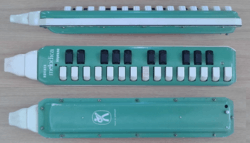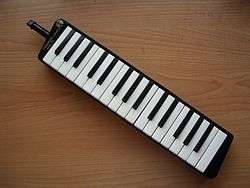Melodica
|
A Hohner melodica | |
| Keyboard instrument | |
|---|---|
| Classification | Wind; free reed aerophone |
| Hornbostel–Sachs classification |
412.132 (Free-reed aerophone) |
| Developed | 1950s |
| Playing range | |
| Usually 2 or 3 octaves | |
| Related instruments | |
| accordion, harmonica, pump organ, yu | |
The melodica, also known as the pianica, blow-organ, key harmonica, or melodyhorn, is a free-reed instrument similar to the pump organ and harmonica. It has a musical keyboard on top, and is played by blowing air through a mouthpiece that fits into a hole in the side of the instrument. Pressing a key opens a hole, allowing air to flow through a reed. The keyboard is usually two or three octaves long. Melodicas are small, light, and portable. They are popular in music education, especially in Asia.
The modern form of the instrument was invented by Hohner in the 1950s,[1] though similar instruments have been known in Italy since the 19th century.[2]
The melodica was first used as a serious musical instrument in the 1960s by composers such as Steve Reich, in his piece titled Melodica (1966)[3] and jazz musician Phil Moore, Jr., on his 1969 Atlantic Records album Right On.[4] Brazilian multi-instrumentalist Hermeto Pascoal developed a technique consisting of singing while playing the melodica, resulting in a wide tonal and harmonic palette.[5] It is associated with Jamaican dub and reggae musician Augustus Pablo who popularized it in the 1970s.[6]
Types


Melodicas are classified primarily by the range of the instrument. Melodicas with different ranges have slightly different shapes.
- Soprano and alto melodicas are higher-pitched and thinner sounding than tenors. Some are designed to be played with both hands at once: the left hand plays the black keys, and the right hand plays the white keys. Others are played like the tenor melodica.
- Tenor melodicas are a lower-pitched type of melodica. The left hand holds a handle on the bottom, and the right hand plays the keyboard. Tenor melodicas can be played with two hands by inserting a tube into the mouthpiece hole and placing the melodica on a flat surface.
- Bass melodicas also exist, but are less common than other tenor, alto, and soprano.
- The Accordina, generally made of metal, uses the same mechanism as a traditional melodica; however, the keyboard is replaced with a button arrangement similar to a chromatic button accordion's keyboard.
Wooden melodicas
Although the majority of melodicas are made of plastic, some are made primarily of wood. The Sound Electra corporation makes the MyLodica, a wooden melodica designed "...to produce a warmer richer sound than that of its plastic relatives."[7] The Victoria Accordion company in Castelfidardo, Italy, produces a range of wooden melodicas and accordinas that they market under the name Vibrandoneon.
Alternative names
The melodica is known by various names, often at the whim of the manufacturer. Melodion (Suzuki), Triola (Seydel), Melodika (Apollo), Melodia (Diana), Pianica (Yamaha), Melodihorn (Samick), Pianetta and Clavietta are just some of the variants. This can lead to some confusion, as many people will use different names as a blanket term to describe all of these instruments. The melodica may colloquially be referred to as a "hooter". This was the source of the name for Philadelphia band, The Hooters.[8]
Two hands
Melodica can be played with two hands employing an air tube.
 Melodica being played horizontally, with two hands and an air tube
Melodica being played horizontally, with two hands and an air tube Melodica being played vertically, with two hands and an air tube
Melodica being played vertically, with two hands and an air tube
To blow air, a foot pump can also be used.[9][10][11]
Comparison with traditional woodwind instruments
Melodicas are unusual because unlike most conventional woodwind instruments, they make use of a piano keyboard rather than a specialized fingering system using holes and/or buttons. This allows the player to use a single finger to play any one note of the instrument's range, rather than requiring several fingers to play individual notes, as is the case with most other woodwinds. The player can then play chords by using their remaining fingers to press additional keys, and thus, sound additional notes. In other words, whereas most woodwind instruments such as saxophones or clarinets are monophonic when played by trained musicians, the melodica is polyphonic.
Additionally, for a beginner, a melodica can play accidentals more easily than a woodwind, which may require extra keys or cross-fingering to reach any notes outside of its key.
These two factors give the melodica an unusual degree of flexibility and contribute to its wide usage in music education.
 |
Clavietta melodica
Solo melodica recording
Recording of a Clavietta melodica playing traditional Irish music, "Rakes of Kildare", played by Troy Banarzi |
| Problems playing this file? See media help. | |
Gallery
 A Suzuki melodion
A Suzuki melodion Hohner alto melodica
Hohner alto melodica Melodica being played vertically, without air tube
Melodica being played vertically, without air tube Patent drawing for accordina
Patent drawing for accordina- Accordina being played
See also
References
- ↑ Missin P (2004). "A Brief History of Mouth-Blown Free Reed Instruments: Melodica Family". Archived from the original on 2013-09-26. Retrieved 2013-07-03.
- ↑ "Vibrandoneon". Duskyrecords.nl. Retrieved 2013-07-03.
- ↑ "Steve Reich - Melodica". Boosey.com. 1966-05-22. Retrieved 2013-07-03.
- ↑ Phil Moore Jr., 1969. Right On, 1969. Atlantic Records (SD-1530)
- ↑ "Hermeto Pascoal - Rebuliço". YouTube. Retrieved 2013-07-03.
- ↑ Kliment and Watchtel (2007). "Augustus Pablo". Retrieved 2013-07-03.
- ↑ "Mylodica". Melodicas.com. Retrieved 2013-07-03.
- ↑ Darling, John (2000). What's in a Name?: The Book of Bands. Writers Club Press. ISBN 978-0-595-09629-9.
- ↑ Odd instruments are music to composers' ears
- ↑ Blow Keyboard with foot pump, using wine cask / bota bag, cork, tubes and a pump, in a similar way to feet bagpipes.
- ↑ Blow keyboard bagpipe mod in Make (magazine)
External links
-
 Media related to Melodicas at Wikimedia Commons
Media related to Melodicas at Wikimedia Commons
